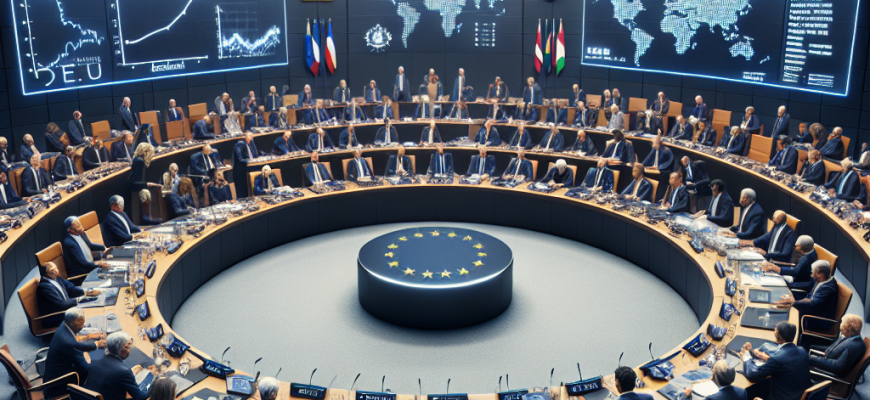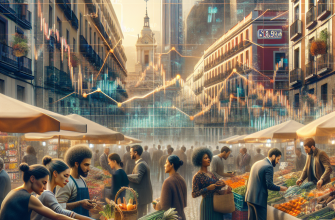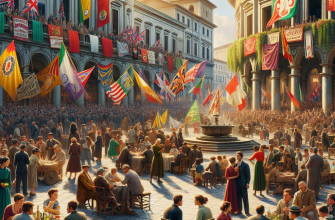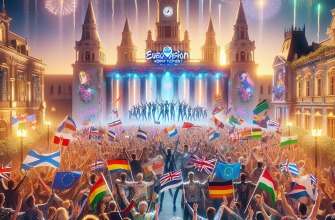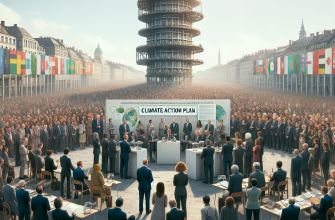- EU Leaders Tackle Energy Crisis: A Wild Ride Amidst Rising Prices
- The Current Energy Situation
- Key Challenges: The Bumps in the Road
- Lack of Funding
- Import Reliance
- Declining Economic Competitiveness
- Lights, Camera, Solutions!
- Clean Industrial Deal
- Diversification and Demand Aggregation
- Technological Neutrality
- Supply-Side Initiatives
- Price Caps and Regulatory Measures
- Coordinated Policy Responses
- International Cooperation: The Global Ties That Bind
- Conclusion: The Road Ahead
EU Leaders Tackle Energy Crisis: A Wild Ride Amidst Rising Prices
Ahoy, my friends! Today, we embark on a journey through the chaotic realm of the European Union’s energy crisis. With the price tags of gas and electricity skyrocketing, it’s not just households feeling the pinch; businesses are buckleling under pressure too. Thanks to colorful twists in geopolitical relations and the urgent need to transition to cleaner energy, it’s a rollercoaster ride directly into the heart of decision-making. Buckle up, because we’re peeling back the multiple layers of this intricate energy onion!
The Current Energy Situation
Would you believe it, folks? The energy crisis we’re witnessing today took a wild turn for the worst with the Russian invasion of Ukraine. As if we were all on some bizarre reality show, Russia curtailed its gas exports to Europe, leaving the continent teetering precariously on the edge of energy chaos. Prices soared higher than a kite on a windy day, leaving both Europeans and their wallets gasping (and groaning). What’s more amusing is how this predicament features our good old friends—government officials and EU leaders—huddling to figure out how to turn this ship around before it capsizes.
Key Challenges: The Bumps in the Road
Lack of Funding
And here we find ourselves at a crossroads: the funds under the shiny banners of REPowerEU and the Recovery and Resilience Facility (RRF) seem like a distant dream. They’ve been mobilized, buzzed away into thin air, leaving the EU’s climate coffers resembling an empty bag of chips after a late-night binge. Don’t get me wrong—ambitions are still as strong as a caffeine-fueled brainstorming session. The approval of the Net Zero Industry Act and the Critical Raw Materials Act are signs that shimmering hope still hovers somewhere above the smoke of existential dread.
Import Reliance
Ever thought about your dependency on that one friend who promises to help you move but always flakes? Welcome to Europe’s energy drama, where the clingy relationship with imported gas is the lead character. The EU leaders have wised up and decided to diversify their energy sources. Long-term contracts and pooling demand are the names of the game now. No more sitting idly by; it’s time to negotiate like a boss and secure supplies for a reasonable price!
Declining Economic Competitiveness
Let’s hit pause for a moment and grasp the reality: the energy crisis isn’t just about power sources. It’s a glaring spotlight shining on the need for the EU to beef up its economic competitiveness. Adapting to the geopolitically charged atmosphere means reinventing industrial policies and doing some heavy lifting—lifting up the entire framework to grapple with the new world order. Time to roll up those sleeves, my friends!
Lights, Camera, Solutions!
Clean Industrial Deal
What’s cooking in the EU kitchen, you ask? That would be the proposed Clean Industrial Deal, hot off the press from the European Commission under the keen eye of President Ursula von der Leyen. Imagine a bold plan akin to a Marshall Plan—EU-funded, mind you—that aims to support low-carbon industries while also throwing a lifeline to the private sector. Simple regulatory frameworks, investments, and low-carbon initiatives are the secret ingredients in this recipe!
Diversification and Demand Aggregation
The EU has also decided to jazz things up with a plan to diversify their energy sources. No more picking just one flavor. Think about gathering bargaining power as a communal tribe, negotiating better deals with a wider range of trustworthy suppliers. The EU Energy Platform is set to play a starring role here, helping to ensure our energy supplies aren’t flimsy like a paper straw, but robust and affordable! We want that LNG and hydrogen flowing, folks!
Technological Neutrality
Okay, let’s talk tech! The EU green taxonomy is undergoing a makeover to embrace an expansive suite of low-emission technologies. We’re not just talking about your usual suspects; nuclear fusion, fission, and even geothermal energy are now in the mix. Embracing technological neutrality sounds like the right approach to simultaneously accelerate energy security and curb emissions. It’s a bit like having your cake and eating it too… if your cake was made of solar panels and wind turbines.
Supply-Side Initiatives
Now, just to reel things in, let’s discuss initiatives aimed at addressing the supply side of this mess. Here’s what’s cooking:
- Pooling Demand: The EU is acting as one mighty buyer to negotiate long-term contracts with gas suppliers, allowing for predictable revenue streams. A single unit, united and strong!
- Maximizing Domestic Supply: Some countries, like the Netherlands, will be nudged to crank up gas production, while Germany’s nuclear plants may need some reconsideration of their closure plans. It’s like playing a strategic game of energy chess.
- Joint EU Funds: Funds may be established to support citizens facing greater risks from expanded energy production. Think earthquake risks in the Netherlands. Safety first, priced right!
Price Caps and Regulatory Measures
Now we come to the spicy debate on price caps for gas transactions. Leaders are split—some believe it’s a necessary measure to stabilize wholesale prices, while others feel it might discourage consumption. Throw in some proposals for revenue caps for low-cost power producers and solidarity contributions from fossil-fuel companies, and you’ve got yourself a pot of bubbling policy!
Coordinated Policy Responses
So how do we untangle this mess? By prioritizing coordinated policy responses that strike while the iron is hot! Retail price caps, regulated tariffs, emergency support for energy-intensive companies—these are just some of the aces up the EU’s sleeve to ensure that responses don’t exacerbate the situation. After all, we want solutions abundant, and the chaos minimal!
International Cooperation: The Global Ties That Bind
As the curtains rise on this global stage, the EU recognizes the indispensable role of international cooperation. This involves deepening ties with external partners for innovation and deployment of technologies, from batteries to electric vehicles, and nuclear energy. Whether it’s bolstering transatlantic cooperation with the United States or forging partnerships with African and Latin American nations, the path to a climate-secure future demands unity. Let’s make connections, my friends!
Conclusion: The Road Ahead
And there you have it—the multifaceted, head-spinning saga of the energy crisis in Europe. From funding hurdles to diversification efforts and all the quirky characters involved, the path forward is anything but simple. With the Clean Industrial Deal as a beacon, diversifying energy sources, and crafting coordinated policy responses, the EU is aiming high. Whether this bold adventure will end with a victory dance or a facepalm moment remains to be seen. But what we know for sure is that collective action, technological neutrality, and strong global partnerships are the keys to building a resilient and sustainable energy future.
So let the discussions continue, keep your energy levels high, and who knows? Together, we might just navigate these stormy waters and emerge triumphant!

